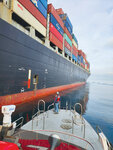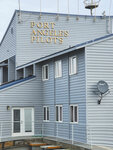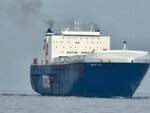


The pilot stood on the open bow of the pilot boat, legs spread, gripping a stanchion to steady himself in the rolling sea. Supported by a deckhand, he prepared to grab the rope ladder dangling down the side of a mammoth container ship, which was making seven or eight knots in the choppy water.
With a cold salt breeze blowing in my face, I watched from the safety of the pilot boat’s bridge. Our boat had matched the ship’s speed and direction, but because of their size difference, the parallel vessels bobbed and weaved in different rhythms. The ladder – a manila rope with wooden slats – was swaying as well. The pilot needed to grab the ladder at exactly the right time, hoist himself onto it over churning waves, then climb a few stories to an open hatch in the ship’s hull.
This maneuver – known as a “transfer” – happens day and night in all kinds of weather in the waters of Puget Sound, every time a pilot boards a vessel entering the Strait of Juan de Fuca.
All commercial foreign flag vessels – container ships (some the length of three football fields), freighters, tankers, cruise ships – are required to have a local pilot on board to navigate the ship through our inland waters. These 52 elite mariners are highly trained, experienced individuals with in-depth knowledge of the waterways, inlets, and channels of the Sound – more than two thousand miles of shoreline. Keeping our ports and waterways safe, protecting property and the environment, they perform a vital service supporting local industry and maintaining global trade. Thousands of vessels are professionally delivered by pilots every year to the ports of Anacortes, Everett, Seattle, Tacoma, and Olympia, carrying over 80 billion dollars’ worth of cargo.
While the ship’s captain retains overall control of the vessel, the pilot has “the con,” or has control over the ship’s navigation. It’s a close working relationship, one pilot explained to me: “The captain knows the ship and the pilot knows the waterways … knows where they’re going.” While steering, pilots keep track of other commercial traffic, as well as fishing boats, Washington state ferries, tug boats, and pleasure craft.
“You can think of us like airline pilots who specialize in takeoffs and landings.” Pilots have performed these services as long as there have been ships delivering cargo.
“Piloting is one of the oldest professions in the world,” one pilot remarked, “dating back to early Roman and Greek times, and it’s a necessary job practiced around the globe.”
In Seattle, a central dispatcher juggles schedules and directs Puget Sound pilot assignments, keeping track of who goes where and when – including state-mandated rest periods between shifts. Inbound ships take a pilot aboard as they pass by Port Angeles; outbound ships have their pilot dropped off at the same spot. The pilot station has dormitory-like quarters as well as cooking, dining, and living space where off-duty pilots can get rest time. Then they get ready to go back out and do it again.
It’s a carefully choreographed dance, and the logistical challenges don’t end with scheduling.
“Sometimes, there is a language barrier,” a pilot told me. “English is the official language used in navigation, so there is supposed to be someone on board who speaks enough English to get by.”
I asked how they made it work.
“It can be tough,” the pilot said. “A ship’s registry and the crew’s nationality aren’t necessarily the same. And sometimes the officers and the crew are from different countries. You do your best.”
Still, the job often leaves little room for error. Later that day, I watched the pilot complete his transfer, swiftly – bravely – grabbing the ladder with practiced self-assurance; timing was everything.
We gunned our engine and pulled away from the ship as the pilot climbed the ladder. Later on I was told that, worldwide, the pilot profession averages one fatality a year.
“However, 2023 was a bad year for us,” one pilot informed me. “There were five deaths.”
He paused for a moment, then added, “Six, if you count the pilot who died in Odessa. He was navigating a Ukrainian ship and was killed in a missile attack.”
Those tragedies stand out. During my day on the water, I witnessed nothing but flawless, expert transfers, and each ship was safely navigated to port.
I asked if bad weather affects their work. “No, there’s always a way to make it happen – and things you can do to prevent risk.”
Despite the dangers the job may entail, my impression after observing and speaking to these professionals is that they love what they do.
When asked what he liked best about his work, one pilot thought for a minute, then said, “On a nice day, cruising up and down Puget Sound . . . I love the water and I love boats. The work is fun.” He smiled and added, “Sure beats being in an office.”
“And the most challenging part?” I asked.
“One hundred thousand tons of steel and bad weather,” he answered emphatically. “You can be a master mariner, but we’re all captive to the elements in the end.” X